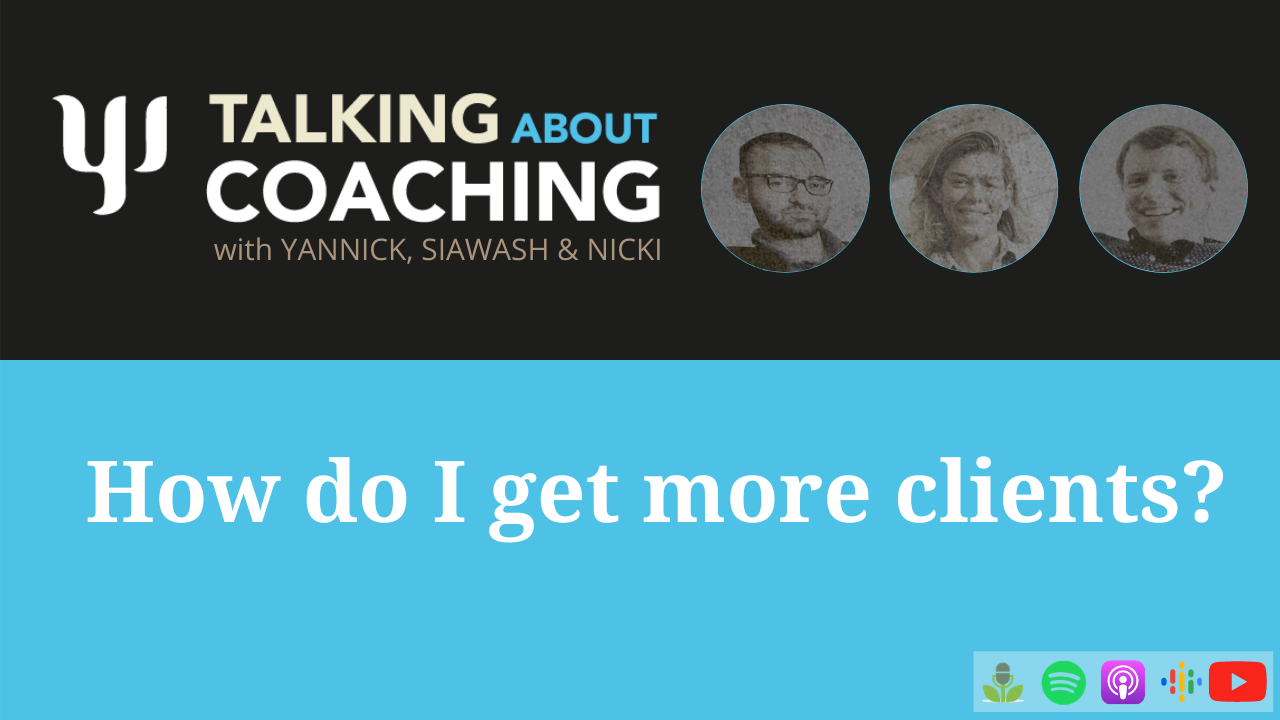*This is part of a series of blog posts created in collaboration with writer and fellow existential coach Marcie Boyer as well as fellow podcasters Siawash Zahmat and Nicki Drab. These articles are aimed at coaches who are just starting out, but you can always send us a question at any level and we’ll cover it for you!
Getting clients is one of the biggest challenges new coaches face.
You’ve finished your training, and, after tapping into your existing network to get your practice hours, you’re now a qualified coach. With your business cards printed, your website online, you’re now ready to hit the ground running.
But you hit a brick wall.
What do you do next?
How do you find clients?
This is the ‘big one’, perhaps the most frequently asked question. Coaches need clients and clients need coaches. But building that bridge can be tricky, especially if clients don’t know about you or what coaching can do for them.
Often we think of clients as a plural. That is, focusing our attention and efforts on getting the next 5 to 10 new clients. In doing so we may not see the opportunities around us to make a connection with our next client. There are many different approaches to getting more clients.
In this episode of Talking about Coaching, Yannick, Siawash, and Nicki share a few strategies for getting the next client.
1. Slowing Down
When we think of clients in the plural, we may find ourselves in a perpetual hurried state. Rushing to complete the next marketing project or dashing off to the next event in search of the elusive ‘bunch’ of new clients. Thinking of clients in the singular, one person at a time can slow down our thinking. We may begin to see how many people we come in contact with in our everyday lives, at the shop, the gym, or at our workplaces. Most importantly, we may begin to notice the opportunity to make the connection with people who may benefit from coaching.
2. Being Present
Slowing down also allows us to be more present. Seemingly everyday conversations become an opportunity for listening and connecting. When we are present we may notice changes in a person’s tone of voice, subtle emotions, language that give us a sense that a person may benefit from coaching. While it’s useful not to start coaching when we notice these changes, it is however, an opportunity to build a connection for a future conversation.
3. Creating a Coaching Conversation
This can be a bit tricky. We’ve slowed down, opened ourselves to deep listening by being present in our everyday conversations. We may have noticed something is not right, or something that we’ve connected with in another person, or perhaps we noticed something we may be able to work with in the coaching space. How do we take the next step to offer coaching? Believe it or not, it is as simple as saying “how about you make an appointment”?
Here are 3 suggestions for taking the initial conversation to a coaching conversation:
Siawash suggests keeping the initial conversation short.
It’s handy to remember that after having these moments of great conversation, the person you’re speaking with may have to run to another task or job. Being mindful of their time by opening space for an invitation to continue the conversation. Perhaps, we could keep this conversation going over a cup of coffee or tea, a call? Rather than giving them a business card, exchange personal details and get in touch straight away, or arrange a time to meet there and then. (Watch podcast: Siawash shares his thoughts on why he avoids giving out business cards!)
Second, be honest with yourself about your intention for continuing the conversation.
At this point we are offering to listen, to explore, to build a connection we’ve made with another person, who may or may not benefit from coaching. However, it’s important to recognize we may get stumped by our own language. Offering ‘coaching’ without building a connection first may leave the person feeling pressured or thinking it’s all about the money. Few coaches would find a hard sell approach appealing. Being honest with ourselves and being clear in our intention to continue the conversation facilitates a natural opening that might lead to a future coaching relationship. And if not, that’s okay, you will have had an interesting conversation either way. You’d be surprised where these conversations that “went nowhere” sometimes end up leading.
Lastly, find your own way to be transparent about coaching while setting the tone for the next conversation.
You may want to get in touch to say it was nice meeting you and look forward to our next conversation. You may suggest you meet at a time when the person can be present, in a quiet place, inviting them to take time out for themselves.
Finding clients is one of the biggest challenges coaches face.
However, you can make it a bit easier for yourself by reframing how you think about clients (in the singular), and with a bit of practice you can find opportunities in everyday conversations to connect with your next potential client.
Enjoyed this blog? Watch the full video below or listen to the episode of the podcast via Spotify, Apple Podcasts, Google Podcasts or download the episode via Buzzsprout.

